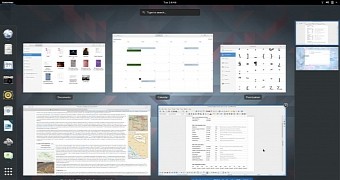We reported earlier on the release of the GNOME 3.21.3 desktop environment, which was made available for early adopters and public testers who want to see what's coming to GNOME 3.22 later this year.
The GNOME Shell user interface and Mutter window and compositing manager have been updated to version 3.21.3 as well, and we would like to tell you all about the improvements and new features that landed in these new development releases.
Let's start with GNOME Shell, which is the most important part of the GNOME desktop environment for end users. The GNOME Shell 3.21.3 release plugs a memory leak, implements support for VPN (Virtual Private Network) service aliases in the network agent, and will no longer disable the suspend action when its locked.
On the other hand, Mutter 3.21.3 ships with various fixes and enhancements to the Wayland display server, which might just become standard for many GNU/Linux distributions later this year. These include better window positioning when unmaximizing through drag and drop, and support for the kill() function to force-quit unresponsive clients.
GNOME 3.21.3 available for public testing now
Also new in the Mutter 3.21.3 development release is support for transmitting the tiled state of windows to the GTK+ GUI toolkit when running GNOME on the next-generation Wayland display server. Moreover, window titles and wm_class can now be converted to the UTF-8 encoding standard.
Last but not least, Mutter will no longer generate an invalid UTF-8 window description string, and now avoids full window redraws when the extended frame sync is being used. Both Mutter 3.21.3 and GNOME Shell 3.21.3 development releases are available for testing as part of today's GNOME 3.21.3 desktop release.
Don't forget that these are pre-release versions, which means that some issues are still present. Although, you are encouraged to test these development snapshots and report bugs on the GNOME Bugzilla. The GNOME 3.22 desktop environment will be released in its final, production-ready state later this year, on September 21.

 14 DAY TRIAL //
14 DAY TRIAL //